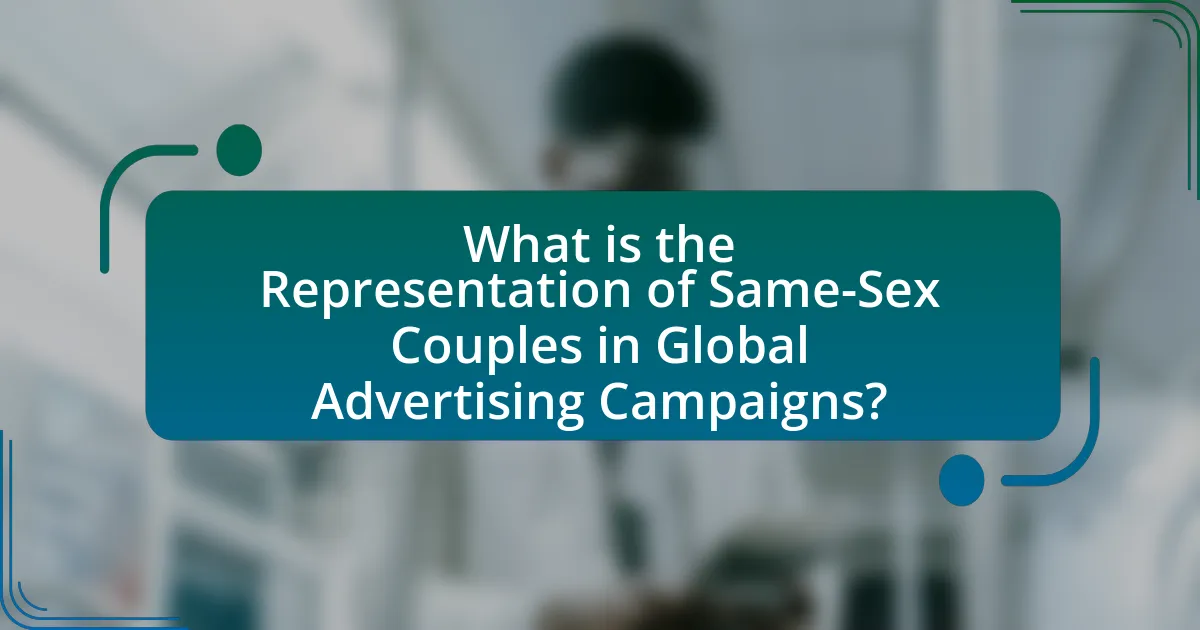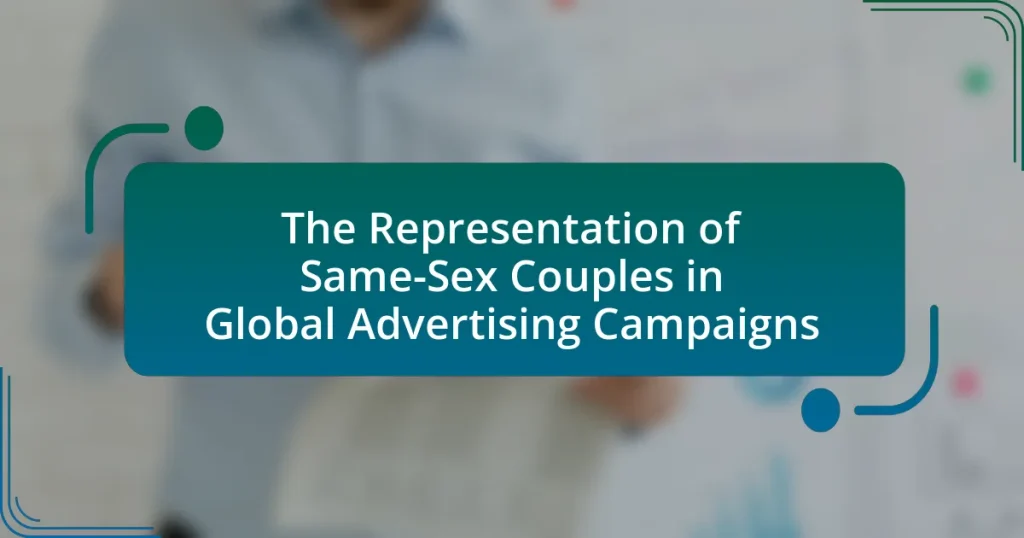The article examines the representation of same-sex couples in global advertising campaigns, highlighting a significant increase in visibility over the past decade. Research indicates that brands are increasingly featuring same-sex couples to reflect societal changes and promote inclusivity, with notable growth during Pride Month. The evolution of representation is influenced by historical milestones, cultural attitudes, and consumer preferences, demonstrating the economic benefits of inclusivity. The article also addresses the challenges brands face, the impact of representation on societal norms, and best practices for ensuring authenticity in advertising.

What is the Representation of Same-Sex Couples in Global Advertising Campaigns?
The representation of same-sex couples in global advertising campaigns has increased significantly over the past decade. Research indicates that brands are increasingly featuring same-sex couples to reflect societal changes and promote inclusivity, with a notable rise in visibility during Pride Month and LGBTQ+ events. For instance, a 2021 study by the LGBTQ+ advocacy group GLAAD found that 50% of ads during Pride Month featured LGBTQ+ representation, compared to just 10% in 2015. This shift not only aligns with consumer demand for diversity but also enhances brand loyalty among LGBTQ+ consumers, as 83% of LGBTQ+ individuals reported being more likely to support brands that represent them authentically.
How has the representation of same-sex couples evolved in advertising?
The representation of same-sex couples in advertising has evolved significantly from invisibility to visibility and acceptance. Initially, same-sex couples were largely absent from mainstream advertising, reflecting societal taboos and discrimination. However, by the late 20th century, brands began to recognize the purchasing power of LGBTQ+ consumers, leading to more inclusive portrayals. For instance, in the 1990s, brands like Absolut Vodka and IKEA featured same-sex couples in their campaigns, signaling a shift towards representation. By the 2010s, major companies such as Coca-Cola and Apple embraced same-sex relationships in their advertisements, showcasing them as normal and relatable. This evolution is supported by research indicating that 70% of LGBTQ+ consumers prefer brands that support their community, highlighting the commercial benefits of inclusivity.
What historical milestones have influenced this evolution?
The representation of same-sex couples in global advertising campaigns has been significantly influenced by key historical milestones such as the decriminalization of homosexuality in various countries, the legalization of same-sex marriage, and the rise of LGBTQ+ rights movements. For instance, the Stonewall Riots in 1969 marked a pivotal moment in the fight for LGBTQ+ rights, leading to increased visibility and acceptance of same-sex relationships. Additionally, the U.S. Supreme Court’s ruling in Obergefell v. Hodges in 2015, which legalized same-sex marriage nationwide, further encouraged brands to authentically represent same-sex couples in their advertising. These milestones have collectively shaped societal attitudes, prompting advertisers to embrace diversity and inclusivity in their campaigns.
How do cultural attitudes impact the representation of same-sex couples?
Cultural attitudes significantly influence the representation of same-sex couples in advertising campaigns. In societies with progressive views on LGBTQ+ rights, same-sex couples are often depicted positively, reflecting acceptance and inclusivity, which can enhance brand loyalty among diverse consumer bases. Conversely, in cultures with conservative attitudes, representations may be limited or negative, as brands fear backlash or alienation from traditional consumers. For instance, a study by the Pew Research Center in 2020 found that acceptance of same-sex relationships varies widely across countries, impacting how brands choose to portray these couples in their marketing strategies. This demonstrates that cultural context directly shapes the visibility and portrayal of same-sex couples in global advertising.
Why is the representation of same-sex couples important in advertising?
The representation of same-sex couples in advertising is important because it fosters inclusivity and reflects societal diversity. By showcasing same-sex couples, brands can connect with a broader audience, enhancing relatability and customer loyalty. Research indicates that 70% of LGBTQ+ consumers are more likely to support brands that represent them positively in advertising, demonstrating the economic impact of such representation. Furthermore, inclusive advertising can challenge stereotypes and promote acceptance, contributing to a more equitable society.
What role does representation play in consumer perception?
Representation significantly influences consumer perception by shaping how individuals identify with brands and products. When consumers see themselves reflected in advertising, particularly through diverse representations such as same-sex couples, it fosters a sense of inclusion and relatability. Research indicates that inclusive representation can enhance brand loyalty; for instance, a study by the American Psychological Association found that consumers are more likely to purchase from brands that authentically represent their identities. This connection between representation and consumer perception underscores the importance of diversity in advertising, as it not only impacts consumer attitudes but also drives purchasing behavior.
How can representation affect brand loyalty among LGBTQ+ consumers?
Representation significantly affects brand loyalty among LGBTQ+ consumers by fostering a sense of inclusion and validation. When brands authentically represent LGBTQ+ individuals and couples in their advertising, they create emotional connections that resonate with these consumers. Research indicates that 70% of LGBTQ+ consumers are more likely to support brands that actively promote diversity and inclusion in their marketing efforts. This connection enhances brand loyalty, as consumers feel recognized and valued, leading to increased trust and preference for those brands over competitors that lack representation.

What are the current trends in the representation of same-sex couples in advertising?
Current trends in the representation of same-sex couples in advertising include increased visibility, authenticity, and diversity. Brands are now featuring same-sex couples in mainstream campaigns, reflecting societal acceptance and the growing influence of LGBTQ+ consumers. For instance, a 2021 report by the LGBTQ+ advocacy group GLAAD noted that 20% of ads included LGBTQ+ representation, a significant increase from previous years. Additionally, advertisers are focusing on authentic storytelling that resonates with LGBTQ+ experiences, moving away from stereotypes and tokenism. This shift is supported by research indicating that consumers are more likely to engage with brands that represent diverse relationships, highlighting the importance of inclusivity in marketing strategies.
How are brands incorporating same-sex couples into their campaigns?
Brands are incorporating same-sex couples into their campaigns by featuring them prominently in advertisements, showcasing diverse family structures and relationships. For instance, companies like IKEA and Target have included same-sex couples in their marketing materials to reflect societal changes and promote inclusivity. Research indicates that 70% of LGBTQ+ consumers feel more positively about brands that feature same-sex couples, demonstrating the effectiveness of this strategy in building brand loyalty and resonance with a broader audience.
What types of products are most commonly advertised with same-sex couples?
Products most commonly advertised with same-sex couples include consumer goods, fashion items, travel services, and home-related products. Research indicates that brands in the beauty and personal care sectors, such as cosmetics and grooming products, frequently feature same-sex couples to resonate with diverse audiences. Additionally, the hospitality and travel industries often utilize same-sex couples in their marketing to promote inclusivity and appeal to LGBTQ+ travelers. A study by the American Psychological Association highlights that representation of same-sex couples in advertising can enhance brand loyalty among LGBTQ+ consumers, demonstrating the effectiveness of this marketing strategy.
How do different regions approach the representation of same-sex couples?
Different regions approach the representation of same-sex couples in advertising with varying degrees of acceptance and visibility. In North America and Western Europe, same-sex couples are often portrayed positively, reflecting broader societal acceptance and legal recognition of same-sex marriage; for instance, in the United States, 70% of adults support same-sex marriage as of 2021, according to a Gallup poll. Conversely, in regions such as parts of Africa and the Middle East, representation is often limited or negative due to prevailing cultural and legal opposition to homosexuality, with countries like Uganda enforcing strict anti-LGBTQ+ laws. In Asia, the approach varies significantly; countries like Taiwan have legalized same-sex marriage, leading to more inclusive advertising, while others maintain conservative views that restrict representation. This disparity highlights how cultural, legal, and societal factors influence the portrayal of same-sex couples in global advertising campaigns.
What challenges do brands face when representing same-sex couples?
Brands face several challenges when representing same-sex couples, primarily including societal backlash, authenticity concerns, and market segmentation. Societal backlash occurs as some consumers may react negatively to same-sex representation, potentially leading to boycotts or loss of customer loyalty. Authenticity concerns arise when brands are perceived as exploiting LGBTQ+ relationships for profit without genuine support for the community, which can damage brand reputation. Market segmentation presents a challenge as brands must navigate diverse consumer attitudes towards same-sex couples across different cultures and regions, making it difficult to create universally accepted campaigns. These challenges highlight the complexities brands encounter in balancing representation with consumer expectations and societal norms.
What backlash or criticism can arise from these representations?
Backlash or criticism from the representation of same-sex couples in global advertising campaigns can arise from various societal and cultural perspectives. Critics often argue that such representations can lead to accusations of tokenism, where brands are perceived as exploiting LGBTQ+ identities for profit without genuine support for the community. Additionally, backlash may stem from conservative groups who oppose the normalization of same-sex relationships, leading to boycotts or negative publicity for brands. For instance, in 2019, a campaign featuring a same-sex couple by a major beverage company faced significant backlash in certain markets, resulting in calls for boycotts from conservative factions. This illustrates how representations can provoke strong reactions based on cultural values and beliefs.
How do brands navigate cultural sensitivities in diverse markets?
Brands navigate cultural sensitivities in diverse markets by conducting thorough market research to understand local customs, values, and beliefs. This research informs their marketing strategies, ensuring that messaging resonates positively with the target audience while avoiding potential cultural missteps. For instance, brands like Coca-Cola and McDonald’s have tailored their advertising campaigns to reflect local traditions and preferences, demonstrating cultural awareness and respect. Additionally, brands often collaborate with local influencers or cultural experts to gain insights and validate their approaches, which further enhances their credibility and acceptance in varied cultural contexts.

What impact does the representation of same-sex couples have on society?
The representation of same-sex couples positively impacts society by promoting acceptance and reducing stigma. Research indicates that visibility of same-sex relationships in media and advertising fosters greater social acceptance, as evidenced by a 2019 study published in the Journal of Advertising Research, which found that inclusive advertising leads to increased brand loyalty among LGBTQ+ consumers and allies. Furthermore, representation contributes to normalizing diverse family structures, which can enhance understanding and empathy within communities, ultimately leading to a more inclusive society.
How does advertising influence societal norms regarding same-sex relationships?
Advertising significantly influences societal norms regarding same-sex relationships by normalizing and promoting visibility for LGBTQ+ identities. Through inclusive campaigns, brands such as Nike and Coca-Cola have showcased same-sex couples, which helps to challenge stereotypes and foster acceptance. Research indicates that exposure to positive representations of same-sex relationships in media can lead to increased support for LGBTQ+ rights and reduced prejudice. For instance, a study published in the Journal of Advertising found that advertisements featuring same-sex couples positively impacted viewers’ attitudes towards LGBTQ+ individuals, demonstrating that advertising can play a crucial role in shaping societal perceptions and norms.
What evidence exists to support changes in public perception due to advertising?
Research indicates that advertising featuring same-sex couples positively influences public perception towards LGBTQ+ communities. A study by the Williams Institute found that exposure to inclusive advertising correlates with increased acceptance of same-sex relationships among viewers. Furthermore, a survey conducted by GLAAD revealed that 72% of respondents felt more favorable towards brands that feature LGBTQ+ individuals in their campaigns. These findings demonstrate that targeted advertising can effectively shift societal attitudes and enhance visibility for marginalized groups.
How can advertising contribute to greater acceptance of LGBTQ+ individuals?
Advertising can contribute to greater acceptance of LGBTQ+ individuals by promoting inclusive narratives and representations that normalize diverse sexual orientations and identities. When brands feature LGBTQ+ individuals and couples in their campaigns, they challenge stereotypes and foster visibility, which can lead to increased understanding and acceptance among the general public. For instance, a study by the Williams Institute found that positive portrayals of LGBTQ+ individuals in media can significantly influence public attitudes, leading to greater acceptance and support for LGBTQ+ rights. By consistently showcasing LGBTQ+ stories and experiences, advertising can play a pivotal role in shaping societal norms and reducing stigma.
What best practices should brands follow when representing same-sex couples?
Brands should ensure authentic representation of same-sex couples by prioritizing inclusivity and avoiding stereotypes. Authentic representation involves showcasing diverse relationships that reflect real-life experiences, which can foster a sense of belonging among LGBTQ+ consumers. Research indicates that 70% of LGBTQ+ individuals feel more positively about brands that represent them accurately in advertising, highlighting the importance of genuine portrayals. Additionally, brands should engage with LGBTQ+ communities during the creative process to ensure sensitivity and relevance, as this collaboration can lead to more impactful and respectful messaging.
How can brands ensure authenticity in their representation?
Brands can ensure authenticity in their representation by engaging with the communities they aim to represent and incorporating their voices into the creative process. This approach fosters genuine connections and reflects real experiences, which is crucial for building trust. Research indicates that 70% of consumers are more likely to support brands that demonstrate inclusivity and authenticity in their marketing efforts. By collaborating with LGBTQ+ individuals and organizations, brands can create campaigns that resonate authentically with their target audience, thereby enhancing credibility and relatability.
What strategies can brands use to engage LGBTQ+ audiences effectively?
Brands can engage LGBTQ+ audiences effectively by prioritizing authentic representation and inclusivity in their marketing strategies. This involves showcasing diverse LGBTQ+ identities and experiences in advertisements, which fosters a sense of belonging and connection. Research indicates that 70% of LGBTQ+ consumers are more likely to support brands that demonstrate genuine commitment to the community through inclusive messaging and representation (source: GLAAD’s Accelerating Acceptance report). Additionally, brands should collaborate with LGBTQ+ creators and influencers to ensure authenticity and relatability in their campaigns, further enhancing engagement and trust within the community.


